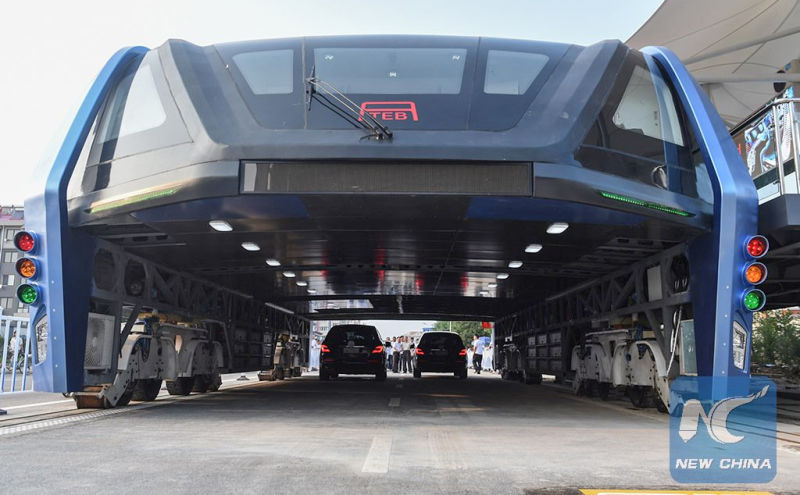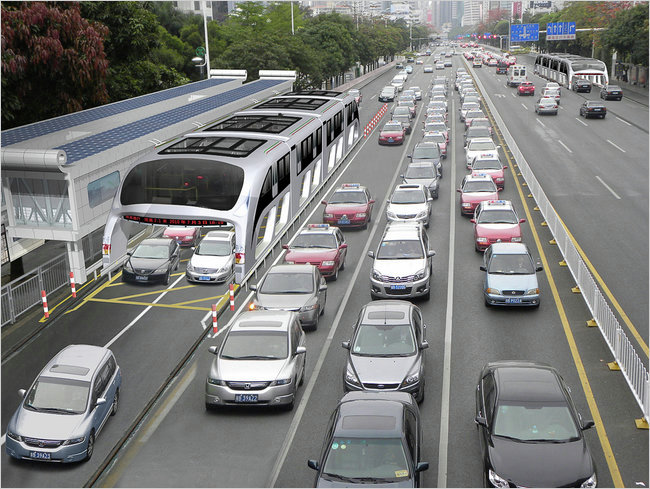Transit Elevated Bus (TEB)
Contents |
[edit] Concept
In August 2016, a futuristic public transport solution, the Transit Elevated Bus (TEB), began being tested in Qinhuangdao, China.
Chinese company Shenzhen Huashi Future Parking Equipment proposed the innovative design as a way of addressing the problem of congestion caused by rapid urbanisation and population growth of many of China's cities.
The TEB is a bus that straddles traffic by driving over the top of it, running along fixed tracks. Its main compartment is elevated, leaving the street clear for cars underneath. The design also incorporates solar panels on the roof and at bus stops to partially power the vehicle.
The vehicles could be capable of holding up to 1,200 passengers each and travel at 40 m/h (60 km/h). Designers estimate that the vehicles could reduce traffic congestion on main roads by 25-30%. They also highlight the relative affordability of the system - the construction cost of one TEB and 25 miles of route facilities is estimated at around $7.4 m, one-tenth the cost of building the same length of subway line.
Youzhou Song, the vehicle’s designer said: “The straddling bus could replace up to 40 conventional buses, potentially saving the 860 tons of fuel that 40 buses would consume annually, and preventing 2,640 tons of carbon emissions.”
[edit] Prototype
When the designs were first proposed many around the world greeted them with scepticism, however, testing on a prototype began in August 2016. The bus measures 22 m in length x 7.8 m wide (72 ft x 25 ft),
The testing is taking place on 300 metre-long test track, evaluating the braking system, drag and power consumption. Once complete, it will progress on to further testing stages.
But the TEB isn’t ready to deal with competing traffic just yet. For now, the TEB is limited to a 300 meter long test track that will evaluate the braking system, drag and power consumption. Once complete, the straddling bus will move on to further testing stages.
Despite being an unproven solution, countries such as Brazil, France and India have expressed their interest in introducing TEBs of their own.
[edit] Updates
In June 2017, the Chinese press reported that the idea of TEB as a mass-transport system had been abandoned.
Having had a prototype developed, reports suggest that those who tested it were left underwhelmed, with some saying that it ran too slowly and became overheated.
Other issues that have been cited for the scrapping of the elevated bus include the way it interacts with other vehicles, particularly those fitted with roof-racks, and other features of the city environment, such as low bridges.
[edit] Find out more
[edit] Related articles on Designing Buildings Wiki
Featured articles and news
Latest Build UK Building Safety Regime explainer published
Key elements in one short, now updated document.
UKGBC launch the UK Climate Resilience Roadmap
First guidance of its kind on direct climate impacts for the built environment and how it can adapt.
CLC Health, Safety and Wellbeing Strategy 2025
Launched by the Minister for Industry to look at fatalities on site, improving mental health and other issues.
One of the most impressive Victorian architects. Book review.
Common Assessment Standard now with building safety
New CAS update now includes mandatory building safety questions.
RTPI leader to become new CIOB Chief Executive Officer
Dr Victoria Hills MRTPI, FICE to take over after Caroline Gumble’s departure.
Social and affordable housing, a long term plan for delivery
The “Delivering a Decade of Renewal for Social and Affordable Housing” strategy sets out future path.
A change to adoptive architecture
Effects of global weather warming on architectural detailing, material choice and human interaction.
The proposed publicly owned and backed subsidiary of Homes England, to facilitate new homes.
How big is the problem and what can we do to mitigate the effects?
Overheating guidance and tools for building designers
A number of cool guides to help with the heat.
The UK's Modern Industrial Strategy: A 10 year plan
Previous consultation criticism, current key elements and general support with some persisting reservations.
Building Safety Regulator reforms
New roles, new staff and a new fast track service pave the way for a single construction regulator.
Architectural Technologist CPDs and Communications
CIAT CPD… and how you can do it!
Cooling centres and cool spaces
Managing extreme heat in cities by directing the public to places for heat stress relief and water sources.
Winter gardens: A brief history and warm variations
Extending the season with glass in different forms and terms.
Restoring Great Yarmouth's Winter Gardens
Transforming one of the least sustainable constructions imaginable.
























